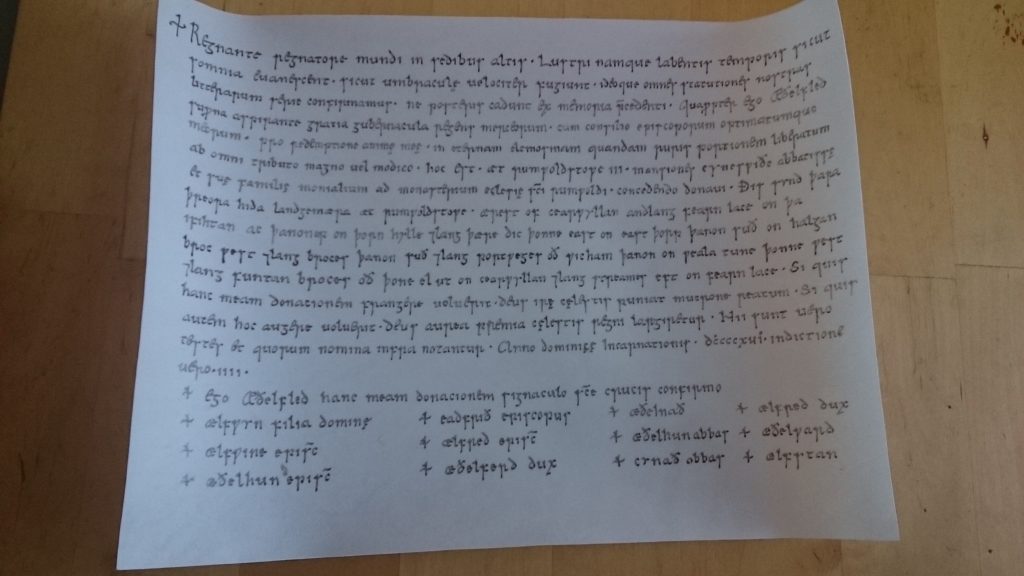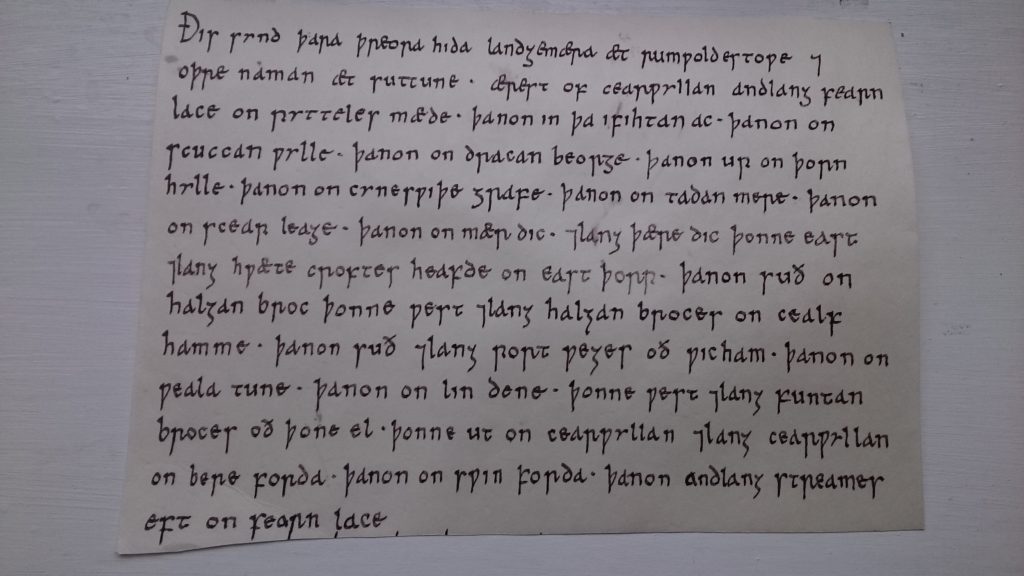The charter marks the foundation of the monastery of Rumwoldstow in 916, recording the gift of the estate of Rumwoldstow, granted by the Lady Æthelflæd to Abbess Cyneswithe and her nuns.
Anglo-Saxon charters like this documented the ceremonial occasion at a council meeting at the royal court when the gift of land was made.
The charter acted as proof that the monastery owned the land (landowners sometimes had to ask the king for replacement charters when the original was destroyed or stolen). So, this charter is the most precious document in Sister Æscwynn’s archive of monastery records.
The charter is mostly written in Latin, the language used by Anglo-Saxons for legal and religious purposes, and it has the typical structure and content of Anglo-Saxon charters.
It begins with a dedication to God, and a reference to the need to keep written records of grants. Lady Æthelflæd explains that she is making the gift for the redemption of her soul, and that the land will be free of taxes. Rumwoldstow is described as being three hides in extent; a hide was partly a measure of land (often 120 acres) and partly a rating of its potential taxable value. The next section, the bounds, is in Old English and describes the features around the boundary of the estate. Reverting to Latin, there is a curse for anyone who infringes the terms of the charter and a blessing for anyone who adds to the gift. The charter ends with the year of the grant and the names of the witnesses, the people present at Æthelflæd’s council meeting.
Fact versus fiction
Rumwoldstow is fictional, and so is our charter, but it is closely based on extant Anglo-Saxon land charters and incorporates on the local geography and the type of landmarks that were used to define land grants.
Walton is the real original birthplace of our own Saint Rumwold, so would be a likely place of pilgrimage, locally at least.
In writing the charter, Katie Hambrook followed the hand of the A.D. 901 charter catalogued in 1968 by Peter Sawyer as 221.1
Text and translation of the charter
Regnante regnatore mundi in sedibus altis. Lustri namque labentis tempora sicut somnia evanescent, sicut umbraculae velociter fugiunt, ideoque omnes statutiones nostras litterarum serie confirmamus, ne posteris cadunt ex memoria p’cedenti.
The Ruler of the world ruling on his high throne. For the periods of falling time-cycles vanish like dreams, fly swiftly like shadows, and so we confirm all our decrees in writing, lest the decrees that went before fall from the memory of those who come after.
Quapropter ego Æðelfled, sup’na aspirante gratia gubernacula regens Merceorum, cum consilio episcoporum optimatumque meorum, pro redemptione animae meae, in eternam elemosinam quandam ruris portionem liberatam ab omni tributo magno vel modico . hoc est . æt Rumwoldstowe iii . mansiones Cyneswithe abbatissae et suae familiae monialium ad monasterium ecclesiae s’ti Rumwoldi . concedendo donavi.
Therefore I Æthelflæd, by the highest grace, ruling governer of the Mercians, with the counsel of my bishops and nobles, for the redemption of my soul, give and grant in eternal charity a certain portion of land freed from every tax great or small, that is 3 hides at Rumwoldstow, to Abbess Cyneswithe and her household of nuns at the monastery of the church of St Rumwold.
Ðis synd þara þreora hida landgemæra æt rumwoldestowe, ærest of cearwyllan andlang fearn lace on þa ifihtan ac þanon up on thorn hylle andlang þære dic Þonne east on east Þorp þanon suð on halgan broc west andlang broces þanon suð andlang port weges oð wicham þanon on weala tune Þonne west
andlang funtan broces oð Þone el ut on cearwyllan andlang streames eft on fearn lace.
These are the land-boundaries of the three hides at Rumwoldstow. First from the Cherwell along fern stream to the ivy-covered oak. From there to up to thorn hill along the ditch then east to Astrup. From there south to the saint’s stream, west along the stream. From there south along the Portway as far as Wickham. From there to Walton, then west along the spring stream as far as the island. Out to the Cherwell; along the Cherwell back to fern stream.
Si quis hanc meam donacionem frangere voluerit, deus irae caelestis puniat mucrone reatum. Si quis autem hoc augere voluerit, deus aurea premia caelestis regni largiretur.
If anyone wishes to infringe my grant, may God punish his guilt with the sword of heavenly anger. But if anyone wishes to add to this grant, may God bestow on him the golden rewards of the heavenly kingdom.
Hii sunt uero testes et quorum nomina infra notantur . Anno dominicae incarnacionis . dccccxvi . indictione . uero . iiii .
These are the witnesses in truth and their names are recorded below. In the year of Our Lord’s incarnation 916, in the true indiction 4.
- Ego Æðelfled hanc meam donacionem signaculo sancte crucis confirmo
- Ælfwyn filia dominae + Eadfrið episcopus + Æðelnað + Ælfred dux
- Ælfwine episc’ + Ælfred episc’ + Æðelhun abbas + Æðelward
- Æðelhun episc’ + Æðelferd dux + Cynað abbas +Ælfstan
I Æthelflæd confirm this my grant with the holy sign of the cross
Ælfwyn daughter of the Lady; Bishop Eadfrith; Æthelnath; Ealdorman Ælfred
Bishop Ælfwine; Bishop Ælfred; Abbot Æthelhun; Æthelward
Bishop Æthelhun; Ealdorman Æthelferd; Abbot Cynath; Ælfstan

The draft charter
The first document that Sister Æscwynn drew up is a draft for Rumwoldstow’s charter bounds. Charter bounds are a list of the landmarks around the boundary of a piece of land, an alternative to using a map to define the extent of a piece of property. They were used in Anglo-Saxon charters, legal documents which granted ownership of a piece of land.
The draft charter bounds were drawn up as part of the preparation for the Lady Æthelflæd’s grant to Abbess Cyneswithe of the estate at Rumwoldstow when the monastery was refounded in 916. Local men were summoned to walk around the bounds of the estate, listing the names of all the landmarks. Cyneswithe had these written up by a priest so that they could be included in the charter when Lady Æthelflæd granted her the land. In fact, the bounds were rather too detailed and Lady Æthelflæd’s scribes abbreviated them considerably when they wrote out the charter. Sister Æscwynn keeps the draft bounds with her archive of the other monastery documents.

Transcription and translation of the draft charter
Ðis synd þara þreora hida landgemæra æt rumwoldes stowe and
These are the land-boundaries of the three hides at Rumwoldstow and
oþre naman æt suttune Ærest of cearwyllan andlang fearn
its other name is Sutton. First from the Cherwell along fern
lace on pytteles mæde þanon in þa ifihtan ac þanon on
stream to the hawk’s meadow. From there to the ivy-covered oak. From there to
scuccan wylle þanon on dracan beorge þanon up on thorn
the demon’s spring. From there to the dragon’s barrow. From there up to thorn
hylle þanon on cuneswithe grafe þanon on tadan mere þanon
hill. From there to Cyneswith’s grove. From there to toad pond. From there
on sceap leage þanon on mær dic andlang þære dic Þonne east
to the sheep clearing in the woods. From there to the boundary ditch; along the boundary ditch then east
andlang hwæte croftes heafde on east Þorp þanon suð on
along the top of the wheat field to Astrup. From there south to
halgan broc west andlang halgan broces on cealf
the saint’s stream, west along the saint’s steam to calf
hamme þanon suð andlang port weges oð wicham þanon on
river-meadow. From there south along the Portway as far as Wickham. From there to
weala tune þanon on lin dene Þonne west andlang funtan
Walton. From there to flax valley, then west along
broces oð Þone el ut on cearwyllan andlang cearwyllan
the spring stream as far as the island. Out to the Cherwell; along the Cherwell
on bere forda þanon on swin forda þanon andlang streames
to barley ford. From there to pig ford. From there along the river
eft on fearn lace
back to fern stream.
Footnotes
- A Grant of Æthelred (d. 911) and Æthelflæd (d. 918), rulers of Mercia, to the community of the church of Much Wenlock, from the Cotton collection, and available online at the British Library. https://www.bl.uk/manuscripts/FullDisplay.aspx?ref=Cotton_Ch_VIII_27&index=3